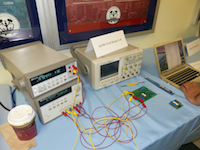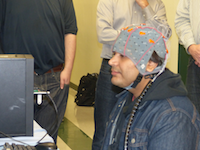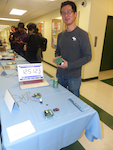Master's Students Project Demonstrations
On December 10th the Electrical Engineering Department hosted a project demonstration featuring the work of its Master’s Degree candidates. These projects were developed in a wide range of classes including the VLSI Design Laboratory, the Principles of RF and Microwave Measurements Lab, the Internet of Things Course, and the Brain-Computer Interfaces Lab.
These project-based courses offer students the opportunity to use the skills they learn in a classroom and apply them in a laboratory setting addressing real-world, open-ended challenges. Such experience is invaluable to enhance students’ post-graduation career prospects in industry or further graduate studies in a competitive Ph.D. program.
In the VLSI Design Laboratory (ELEN 6350) Prof. Peter Kinget guides students in designing a CMOS integrated circuit (IC) during the Spring semester that is subsequently fabricated in an industrial fab during the summer. The prototype chips are then tested and demonstrated by the students in a system application during the Fall semester. The unique focus of this lab is that it offers students the opportunity to go through the complete IC design cycle from system concept, to circuit design, layout, and simulation verification, to testing and demonstration of the fabricated IC. At the end of the course the students record a video presentation in which they demonstrate the system demonstrator including their custom CMOS chip. Videos with the student presentation are posted on the class website: Spring 2014 and Spring 2015.
At the demo presentation session, several projects were on display. Students measured the heart-rate of attendees using their PPG-based ICs, played music from attendees’ phones or FM radio stations using their own class-D audio amplifier ICs. Time was appropriately kept with a digital clock chip designed by the students and ultrasound waves were bouncing around the room to measure distances with a custom ultrasound distance measurement IC. Prof. Kinget commented: “Offering students real-world design projects is key towards their professional success. It augments their classroom experience by allowing them to apply their theoretical knowledge in a real-world setting. The excitement of students when they get their very own chip working is priceless.”
Professor Harish Kirshnaswamy taught ELEN E6903, Principles of RF and Microwave measurements, in which his students developed a 2.5GHz LC-based filter using surface mount components on a board, and a 1GHz amplifier using a discrete GaAs device on board. The former was particularly surprising and impressive. At 2.5GHz, on-board filters are usually implemented using distributed transmission lines. It is extremely hard to build something at 2.5GHz using surface-mount Ls and Cs. It’s a testament to their careful design and modeling and their facility with the design tools that they were able to get such a filter to work. “It is rare for graduate student to build real circuits and measure them with industry-grade measurement equipment, particularly at RF frequencies. I am sure that these skills will be highly valued by industry,” Professor Kirshnaswamy shared.
Internet of Things, ELEN E6765, taught by Professor Zoran Kostic presented three projects. The topic of IoT being on the forefront innovation and so widely applicable, it was no surprise to see the subjects range from digital security to golf putting aides. This course trains students in system-level aspects through the lab sessions. They are exposed to programming, connection and management of sensor devices, gateways and cloud analytic platforms. The training gives them a holistic perspective of real-word problems, allowing them to pursue a comprehensive group project. The course has a unique approach of pushing students out of the comfort of zone of rigid EE topics and provides them with integration skills, including software, critical expertise for graduates of the 21st century.
A team supervised by Professor Nima Mesgarani benefited from his work in interacting with brain signals. “Engineering students are very well positioned to contribute to both hardware development and signal analysis techniques in this area. Our goal is to expose our students to this new area through design projects and hands-on experiments, and motivate and prepare them for the career options in neural engineering and prosthesis fields"
For more pictures from this event please visit the EE Flickr page


